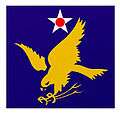742nd Missile Squadron
The 742d Missile Squadron is a United States Air Force unit stationed at Minot Air Force Base, North Dakota. The squadron is equipped with the LGM-30G Minuteman III intercontinental ballistic missile, with a mission of nuclear deterrence.
742d Missile Squadron
 | |
|---|---|
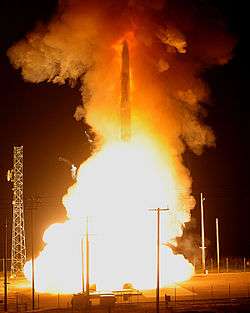 LGM-30G Minuteman III test launch at Vandenberg AFB, California | |
| Active | 1943–1945; 1947–1949; 1956–1957; 1962–present |
| Country | |
| Branch | |
| Role | Intercontinental ballistic missile |
| Part of | Air Force Global Strike Command |
| Garrison/HQ | Minot Air Force Base, North Dakota |
| Nickname(s) | Wolfpack |
| Motto(s) | Clavis Pacis Latin The Key to Peace |
| Engagements | Mediterranean Theater of Operations |
| Decorations | Distinguished Unit Citation Air Force Outstanding Unit Award |
| Commanders | |
| Current commander | Lt. Col. Jared Nelson |
| Insignia | |
| 742d Missile Squadron emblem (modified 4 November 1998 from emblem approved 4 May 1964)[1] | 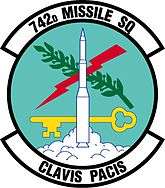 |
| 742d Bombardment Squadron emblem[2][note 1] | 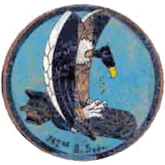 |
The squadron was first activated as the 742d Bombardment Squadron in June 1943. After training in the United States with the Consolidated B-24 Liberator bombers, the 742d deployed to the Mediterranean Theater of Operations, participating in the strategic bombing campaign against Germany. It earned two Distinguished Unit Citations for its combat operations. Following V-E Day, it remained in Italy without its flight echelon until inactivating in September 1945
The squadron was activated in the reserve in 1947, but apparently was not fully manned or equipped before inactivating in June 1949 and transferring its resources to another unit. It was redesignated the 742d Fighter-Day Squadron and activated, but did not become operational before inactivating in July 1957. In November 1962 it was organized as the 742d Strategic Missile Squadron, an LGM-30B Minuteman I squadron. In 1971 it upgraded to the Minuteman III, and is currently a part of the 91st Operations Group.
Mission
The 742d Missile Squadron controls and maintains 50 launch facilities and 5 missile alert facilities. The squadron is divided into missile operations flights, which are responsible for day-to-day operations, maintenance, and security, and an operations support flight, which is responsible for ensuring the readiness of the missile alert facilities.[3]
History
World War II
Training in the United States
The squadron was first activated at Alamogordo Army Air Field, New Mexico on 1 June 1943 as the 742d Bombardment Squadron, one of the four squadrons of the 455th Bombardment Group.[1][4] The initial cadre for the squadron was drawn from the 302d Bombardment Group. In July, a group cadre was given advanced tactical training by the Army Air Forces School of Applied Tactics at Orlando Army Air Base and Pinecastle Army Air Field, Florida. After organizing at Alamogordo, the squadron moved to Utah, where the ground echelon was stationed at Kearns Army Air Base, although flying operations were based at Salt Lake City Army Air Base.[5] After completing training at Langley Field, Virginia, the squadron departed the United States for the Mediterranean Theater of Operations in December 1943.[1] The air echelon began staging through Mitchel Field, New York to ferry their Liberators via the southern ferry route.[6] The ground echelon sailed on the SS William T. Barry.[7]
Combat operations
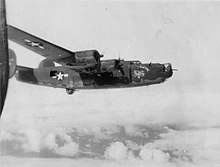
The air echelon of the squadron was delayed in Tunisia and was not entirely lodged at the squadron's combat station of San Giovanni Airfield, Italy until 1 February 1944, and the squadron flew its first mission that month. The squadron was engaged primarily in the strategic bombing campaign against Germany, attacking targets like airfields, factories, oil refineries, harbors, marshalling yards in Italy, France, Germany, Austria, Hungary, Romania, and Yugoslavia.[4]
On 2 April 1944, the squadron attacked a ball bearing plant at Steyr, Austria for which it earned a Distinguished Unit Citation (DUC). The primary target, the Daimler-Pusch aircraft engine factory was obscured by clouds, so the unit attacked the nearby ball bearing plant although attacks by an estimated 75 twin engine fighters continued through the bomb run and heavy, accurate flak was encountered. The squadron lost two Liberators in the attack, but claimed the destruction of six enemy aircraft. Five crewmembers from one of the B-24s lost in the attack bailed out in territory controlled by Yugoslav Partisans and were able to evade German forces and returned to the squadron a month after the attack.[8]
On 26 June 1944, the squadron encountered fighter opposition that was described as the strongest Fifteenth Air Force had encountered to date, and which destroyed several Liberators of the 455th Group, which was leading the 304th Bombardment Wing on the raid. On this mission, the squadron suffered its heaviest losses of the war, with six planes lost to enemy action. Only one of the squadron's Liberators that reached the target returned safely. The squadron pressed its attack on an oil refinery at Moosbierbaum, Austria, for which it received a second DUC.[4][9]
The squadron provided air support to ground forces in Operation Shingle, the landings at Anzio and the Battle of Monte Cassino in the spring of 1944. It knocked out coastal defenses to clear the way for Operation Dragoon, the invasion of southern France in September. As Axis forces were withdrawing from the Balkan peninsula in the fall of 1944, the squadron bombed marshalling yards, troop concentrations and airfields to slow their retreat. It flew air interdiction missions to support Operation Grapeshot, the Spring 1945 offensive in Northern Italy.[4]
The squadron flew its last combat mission on 25 April 1945 against rail yards at Linz, Austria.[10] Following the surrender of German forces in Italy, it flew some supply missions and transported personnel to ports and airfields for shipment back to the United States. Most of the air echelon returned to the United States, ferrying their aircraft in June. Many of the squadron's remaining personnel were transferred to other units in the 304th Bombardment Wing for shipment back to the United States, while the squadron remained in Italy, serving as a replacement depot. The last of the air echelon departed Italy in July and the squadron was inactivated on 9 September 1945.[1][11]
Air Force reserve
The squadron was reactivated as a reserve unit under Air Defense Command (ADC) at Hensley Field, Texas in June 1947, where its training was supervised by ADC's 4122d AAF Base Unit (later the 2596th Air Force Reserve Training Center). It was nominally a very heavy bomber unit, but the squadron does not appear to have been fully manned or equipped while a reserve unit.[12] In 1948 Continental Air Command (ConAC) assumed responsibility for managing reserve and Air National Guard units from ADC.[13] President Truman’s reduced 1949 defense budget required reductions in the number of units in the Air Force.[14] ConAC also reorganized its reserve units under the wing base organization system in June 1949. As a result, the squadron was inactivated and its personnel and equipment were absorbed by elements of the 443d Troop Carrier Wing, which was activated simultaneously at Hensley Field.[1][15]
Tactical Air Command
The squadron was redesignated the 742d Fighter-Day Squadron and activated at Myrtle Beach Air Force Base, South Carolina in July 1956 as Tactical Air Command planned to organize a second North American F-100 Super Sabre wing there. Some personnel were assigned to the unit, but it never became operational with aircraft. It was inactivated in July 1957 and its few personnel assigned were reassigned to elements of the 354th Fighter-Day Wing.[1][16]
Intercontinental ballistic missile squadron

The squadron was redesignated the 742d Strategic Missile Squadron and activated on 1 January 1963 as an intercontinental ballistic missile squadron at Minot Air Force Base, North Dakota. The squadron was initially equipped with 50 LGM-30B Minuteman Is, and placed its first missile on alert in 1963. The 742d upgraded to the LGM-30G Minuteman III in 1970 to 1971. It has maintained ICBMs on alert ever since.[1]
Squadron missile sites are designated by flight, using one letter of the alphabet, followed by a number. The first site in each flight is #1 and designates the Missile Alert Facility, which consists of an above-ground structure plus an underground launch control center staffed by two officers. The launch facilities, are numbered 2 through 11 and are connected to the launch control center by hardened intersite cables, which also interconnect flights. The 742d includes flights K through O.[17] Squadron missile alert facilities (each controlling 10 missiles) are located as follows:
- K-1 8.8 mi SSW of Kenmare ND, 48°33′02″N 102°07′12″W
- L-1 1.5 mi SW of Bowbells ND, 48°47′21″N 102°16′06″W
- M-1 9.1 mi E of Kenmare ND, 48°40′22″N 101°52′31″W
- N-1 3.7 mi W of Mohall ND, 48°45′34″N 101°35′31″W
- O-1 9.5 mi NW of Maxbass ND, 48°49′28″N 101°16′55″W
The squadron has undergone several changes in assignment that did not affect its mission. In June 1968, the 455th Strategic Missile Wing at Minot was replaced by the 91st Strategic Missile Wing, which moved from Glasgow Air Force Base, Montana to Minot on paper, and the squadron was reassigned to the 91st Wing.[18] In September 1991 Strategic Air Command (SAC) reorganized its combat wings under the combat wing organization, and the 91st Wing's missile squadrons were assigned to the reactivated 91st Operations Group. In 1992, the Air Force reorganized its combat forces. SAC was inactivated and the squadron became an element of Air Combat Command until July of 1993, when it became part of Air Force Space Command. Between 1994 and 1996, the wing was reduced to group level. In December 2009, the Air Force's nuclear capable missile units, including the 742d, were transferred to Air Force Global Strike Command.[1][19][20]
Lineage
- Constituted as the 742d Bombardment Squadron (Heavy) on 14 May 1943
- Activated on 1 June 1943
- Redesignated 742d Bombardment Squadron, Heavy on 6 March 1944
- Inactivated on 9 September 1945
- Redesignated 742d Bombardment Squadron, Very Heavy on 13 August 1947
- Activated in the reserve on 9 September 1947
- Inactivated on 27 June 1949
- Redesignated 742d Fighter-Day Squadron on 7 May 1956
- Activated on 25 July 1956
- Inactivated on 1 July 1957
- Redesignated 742d Strategic Missile Squadron and activated on 18 July 1962 (not organized)
- Organized on 1 January 1963
- Redesignated as 742d Missile Squadron on 1 September 1991[1]
Assignments
- 455th Bombardment Group, 1 June 1943 – 9 September 1945
- 455th Bombardment Group, 9 September 1947 – 27 June 1949
- 455th Fighter-Day Group, 25 July 1956 – 1 July 1957
- Strategic Air Command, 18 July 1962 (not organized)
- 455th Strategic Missile Wing, 1 January 1963
- 91st Strategic Missile Wing, 25 June 1968
- 91st Operations Group, 1 September 1991
- 91st Missile Group, 1 July 1994
- 91st Operations Group, 1 February 1996 – present[1]
Stations
- Alamogordo Army Air Field, New Mexico, 1 June 1943
- Kearns Army Air Base, Utah, 9 September 1943
- Langley Field, Virginia, 5 October – 13 December 1943
- San Giovanni Airfield, Italy, 15 January 1944 – 9 September 1945
- Hensley Field, Texas, 9 September 1947 – 27 June 1949
- Myrtle Beach Air Force Base, South Carolina, 25 July 1956 – 1 July 1957
- Minot Air Force Base, North Dakota, 1 January 1963 – present[1]
Aircraft and missiles
- Consolidated B-24 Liberator, 1943–1945
- LGM-30B Minuteman I, 1963–1971
- LGM-30G Minuteman III, 1968–present[1]
Awards and campaigns
| Award streamer | Award | Dates | Notes |
|---|---|---|---|
| Distinguished Unit Citation | 2 April 1944 | Steyr, Austria, 742d Bombardment Squadron[1] | |
| Distinguished Unit Citation | 26 June 1944 | Austria, 742d Bombardment Squadron[1] | |
| Air Force Outstanding Unit Award | 1 July 1972-30 June 1973 | 742d Strategic Missile Squadron[1] | |
| Air Force Outstanding Unit Award | 1 July 1972-30 June 1973 | 742d Strategic Missile Squadron[1] | |
| Air Force Outstanding Unit Award | 1 July 1976-30 June 1978 | 742d Strategic Missile Squadron[1] | |
| Air Force Outstanding Unit Award | 1 July 1978-30 June 1980 | 742d Strategic Missile Squadron[1] | |
| Air Force Outstanding Unit Award | 1 July 1989-14 February 1991 | 742d Strategic Missile Squadron[1] | |
| Air Force Outstanding Unit Award | 1 September 1993-31 August 1995 | 742d Missile Squadron[1] | |
| Air Force Outstanding Unit Award | 1 September 1995-31 August 1997 | 742d Missile Squadron[1] | |
| Air Force Outstanding Unit Award | 1 October 1998-30 September 2000 | 742d Missile Squadron[1] | |
| Air Force Outstanding Unit Award | 1 October 2000-1 October 2001 | 742d Missile Squadron[1] | |
| Air Force Outstanding Unit Award | 1 January-31 December 2002 | 742d Missile Squadron[1] |
| Campaign Streamer | Campaign | Dates | Notes |
|---|---|---|---|
| Air Offensive, Europe | 15 January 1944–5 June 1944 | 742d Bombardment Squadron[1] | |
| Air Combat, EAME Theater | 15 January 1944–11 May 1945 | 742d Bombardment Squadron[1] | |
| Naples-Foggia | 15 January 1944–21 January 1944 | 742d Bombardment Squadron[1] | |
| Anzio | 22 January 1944–24 May 1944 | 742d Bombardment Squadron[1] | |
| Rome-Arno | 22 January 1944–9 September 1944 | 742d Bombardment Squadron[1] | |
| Central Europe | 22 March 1944–21 May 1945 | 742d Bombardment Squadron[1] | |
| Normandy | 6 June 1944–24 July 1944 | 742d Bombardment Squadron[1] | |
| Northern France | 25 July 1944–14 September 1944 | 742d Bombardment Squadron[1] | |
| Southern France | 15 August 1944–14 September 1944 | 742d Bombardment Squadron[1] | |
| North Apennines | 10 September 1944–4 April 1945 | 742d Bombardment Squadron[1] | |
| Rhineland | 15 September 1944–21 March 1945 | 742d Bombardment Squadron[1] | |
| Po Valley | 3 April 1945–8 May 1945 | 742d Bombardment Squadron[1] |
See also
References
Notes
- Explanatory notes
- This emblem was apparently never approved. See Maurer, Combat Squadrons, p. 731 (no approved emblem as of 1963)
- Aircraft is Ford built Consolidated B-24H-10-FO Liberator, "Fords Folly", serial 42-52249.
- Citations
- Robertson, Patsy (June 9, 2010). "Factsheet 742 Missile Squadron (AFGSC)". Air Force Historical Research Agency. Retrieved October 21, 2016.
- Watkins, pp. 100-101
- No byline (May 8, 2006). "Minot Air Force Base Factsheets: 742nd Missile Squadron". 5th Bomb Wing Public Affairs. Archived from the original on February 25, 2013. Retrieved April 22, 2019.
- Maurer, Combat Units, p. 330
- Asch, et al., pp. 10-13
- Asch, et al., p. 25
- Asch, et al., p.32
- Asch, et al., pp. 61-67
- Asch, et al., pp. 82-85
- Asch, et al., p. 156
- Asch, et al., p. 161
- See Maurer, Combat Squadrons, p. 731 (listing no aircraft for the period 1947-1949)
- "Abstract, Mission Project Closeup, Continental Air Command". Air Force History Index. 27 December 1961. Retrieved March 24, 2014.
- Knaack, p. 25
- Ravenstein, pp. 240-241
- Maurer, Combat Squadrons, p. 731
- Kirkpatrick, Jim. "Minot AFB Minuteman Missile Site Coordinates". University of Wyoming. Retrieved April 20, 2019.
- Ravenstein, pp. 125-128, 250
- Haulman, Daniel L. (July 17, 2009). "Factsheet Air Force Global Strike Command". Air Force Historical Research Agency. Retrieved April 21, 2019.
- Bailey, Carl E. (July 24, 2008). "Factsheet Air Force Space Command". Air Force Historical Research Agency. Retrieved April 21, 2019.
Bibliography
![]()
- Asch, Col Alfred; Graff, Col Hugh R.; Ramey, Lt Col Thomas A. (1991). 455th Bomb Group (H): Flight of the Vulgar Vultures. Appleton WI: Graphic Communications Center. Retrieved April 16, 2019.
- Knaack, Marcelle Size (1978). Encyclopedia of US Air Force Aircraft and Missile Systems (PDF). Vol. 2, Post-World War II Bombers 1945-1973. Washington, DC: Office of Air Force History. ISBN 0-912799-59-5. Retrieved December 17, 2016.
- Maurer, Maurer, ed. (1983) [1961]. Air Force Combat Units of World War II (PDF) (reprint ed.). Washington, DC: Office of Air Force History. ISBN 0-912799-02-1. LCCN 61060979.
- Maurer, Maurer, ed. (1982) [1969]. Combat Squadrons of the Air Force, World War II (PDF) (reprint ed.). Washington, DC: Office of Air Force History. ISBN 0-405-12194-6. LCCN 70605402. OCLC 72556.
- Ravenstein, Charles A. (1984). Air Force Combat Wings, Lineage & Honors Histories 1947-1977. Washington, DC: Office of Air Force History. ISBN 0-912799-12-9.
- Watkins, Robert A. (2009). Insignia and Aircraft Markings of the U.S. Army Air Force In World War II. Volume IV, European-African-Middle Eastern Theater of Operations. Atglen, PA: Shiffer Publishing, Ltd. ISBN 978-0-7643-3401-6.
External links
- Minot AFB Minuteman Missile Site Coordinates
- 91st Missile Wing fact sheet
- 742d Missile Squadron web page

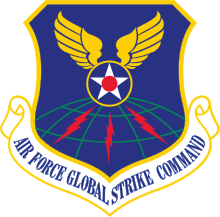


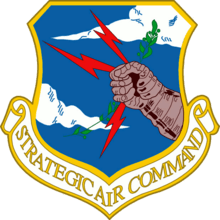
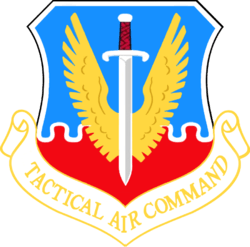
.svg.png)
